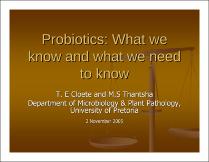JavaScript is disabled for your browser. Some features of this site may not work without it.
- ResearchSpace
- →
- Research Publications/Outputs
- →
- Conference Publications
- →
- View Item
| dc.contributor.author |
Moolman, FS

|
|
| dc.contributor.author |
Cloete, TE

|
|
| dc.contributor.author |
Thantsha, MS

|
|
| dc.date.accessioned | 2009-03-09T09:14:04Z | |
| dc.date.available | 2009-03-09T09:14:04Z | |
| dc.date.issued | 2005-11 | |
| dc.identifier.citation | Moolman, FS, Cloete, TE and Thantsha, MS. 2005. Probiotics: What we know and what we need to know. Prebiotics and probiotics Symposium: Nature’s friendly bacteria an old idea with new marketing possibilities, Volkswagen Centre, Midrand, South Africa, 2 November, pp 21 | en |
| dc.identifier.uri | http://hdl.handle.net/10204/3172 | |
| dc.description | Prebiotics and Probiotics Symposium: Nature’s Friendly Bacteria An Old Idea with New Marketing Possibilities, Volkswagen Centr, Midrand, South Africa, 2 November 2005 | en |
| dc.description.abstract | Prebiotics is a non-digestible food ingredient that beneficially affects the host by selectively stimulating the growth and/or activity of one or a limited number of bacteria in the colon (Roberfroid, 1998; Theuer et al., 1998; Young, 1998; Femia et al., 2002). Probiotics are live microbial cultures fed by mouth and surviving transit through the large intestine where they colonise the system (Frost and Sullivan, 2000; Saarela et al., 2000) SA has large variety of probiotic products in the market comprising fermented milks, tablets and capsules. These South African industries are worth R45 m, with over 11million doses taken annually (ca. 30 000 doses are daily) | en |
| dc.language.iso | en | en |
| dc.subject | Probiotics | en |
| dc.subject | Nature’s friendly bacteria | en |
| dc.subject | Microbiology | en |
| dc.subject | Plant pathology | en |
| dc.title | Probiotics: What we know and what we need to know | en |
| dc.type | Conference Presentation | en |
| dc.identifier.apacitation | Moolman, F., Cloete, T., & Thantsha, M. (2005). Probiotics: What we know and what we need to know. http://hdl.handle.net/10204/3172 | en_ZA |
| dc.identifier.chicagocitation | Moolman, FS, TE Cloete, and MS Thantsha. "Probiotics: What we know and what we need to know." (2005): http://hdl.handle.net/10204/3172 | en_ZA |
| dc.identifier.vancouvercitation | Moolman F, Cloete T, Thantsha M, Probiotics: What we know and what we need to know; 2005. http://hdl.handle.net/10204/3172 . | en_ZA |
| dc.identifier.ris | TY - Conference Presentation AU - Moolman, FS AU - Cloete, TE AU - Thantsha, MS AB - Prebiotics is a non-digestible food ingredient that beneficially affects the host by selectively stimulating the growth and/or activity of one or a limited number of bacteria in the colon (Roberfroid, 1998; Theuer et al., 1998; Young, 1998; Femia et al., 2002). Probiotics are live microbial cultures fed by mouth and surviving transit through the large intestine where they colonise the system (Frost and Sullivan, 2000; Saarela et al., 2000) SA has large variety of probiotic products in the market comprising fermented milks, tablets and capsules. These South African industries are worth R45 m, with over 11million doses taken annually (ca. 30 000 doses are daily) DA - 2005-11 DB - ResearchSpace DP - CSIR KW - Probiotics KW - Nature’s friendly bacteria KW - Microbiology KW - Plant pathology LK - https://researchspace.csir.co.za PY - 2005 T1 - Probiotics: What we know and what we need to know TI - Probiotics: What we know and what we need to know UR - http://hdl.handle.net/10204/3172 ER - | en_ZA |






